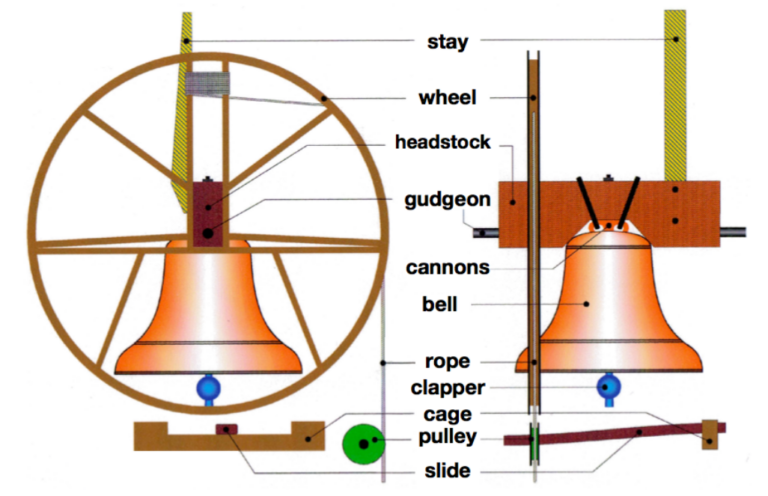There are over 5,000 bell towers for change ringing in England, with less than 300 in the rest of the world. Despite coming in many shapes, sizes and materials, most bell towers have a familiar layout. At the top are the bells, spreading the sound out to the community, below which is usually a clock room. The bellringers usually stand on the ground floor, or first floor if there is a lobby below.
At the top of the tower is the belfry, in which the bells are hung in a wooden or metal frame. Each bell is fixed to the axle of a large wooden wheel that pivots in ball bearings on the frame. A rope is tied to the wheel spokes, runs partly round the rim and falls through holes and pulleys to the ringing chamber below. Clock hammers sit adjacent to the bells and are used to strike the clock chimes.
Bell towers can contain between one and sixteen bells, however most contain six or eight bell. Towers which have four or less bells, are not generally used for change ringing.
Baffle-boarded sound windows, known as louvres, are seen on the outside of the tower and help to spread the sound.
Bell towers often feature a church clock. Behind the wide, decorative faces of church clocks are large mechanisms. Some towers also contain machines known as ‘carillons’, which play the bells in a similar fashion to a keyboard, using hammers to strike to notes. The complicated clock mechanisms used to be wound-up by hand but are now mainly electrically operated.
Finally there’s the ringing chamber. From here the bellringers use the ropes to control the bells. The ropes come down from the ceiling in a circle, usually in pitch order – usually so the strikes go clockwise around the room in descending pitch. Bellringers stand in an inward-facing circle behind the ropes. Often you will find floor mats used to prevent rope wear, boxes for the shorter ringers, and seats for extra ringers. In many ringing chambers, the walls are decorated with boards marking notable peals, a period of non-stop ringing for three hours. Many of these date back hundreds of years.
Bells are made from an alloy of copper and tin and are arranged in the tower down the musical scale from the smallest (called the treble) to the biggest (tenor) which is the lowest note. The average tenor weight is 510kg, although they can weigh up to 4,200kg. The average weight of a tenor bell is similar to that of a small car.

Bells are hung within a wooden or steel frame and attached to a wheel. They rotate around the centre of the wheel, with the clapper in the centre striking the inside of the bell to sound. The special feature of English bells is that they have a stay which allows them to pause in an up-right position. This means the ringer can control when they strike by pulling them from this set position to swing at the correct time.
Within the frame, the bells pivots on the gudgeon as it swings, while the clapper strikes the inside of the bell to make the noise. Although not shown in the video model, the rope wraps around the wheel as it is what the ringer below uses to control the bell’s swing.
Bells have been made, or ‘cast’, in Britain for hundreds of years and, whilst being more refined, the process has changed little. Moulds are made of the bells before molten metal is poured in and left to cool. The bells are left to cool for several days, often in pits as has been done for centuries. Bells are tuned to a particular note, despite actually producing a range of notes at the same time. Once cast, they are spun and metal slowly ground away from the inside. This process flattens the pitch of note the bell makes.
The english style of bellringing is often called full-circle ringing, as the bell’s connection to a wheel allows it to rotate 360 degrees. A ringer must pull the bell at each stroke to make it rotate again for another full circle swing. Each time the ringer pulls the rope the bell swings and sounds. The bell sounds when the clapper hits the inside of the bell near the end of each stroke, so the sound is not produced at the same time as the rope is pulled. In change ringing, it is possible for the bellringers to adjust the time at which they pull their rope to control the speed of striking in order to produce the pattern of changes.
The accompanying slow motion video was recorded at St. John’s Cathedral, Brisbane. The animation shows the position of the bell taken from a sensor attached to the bell wheel.
